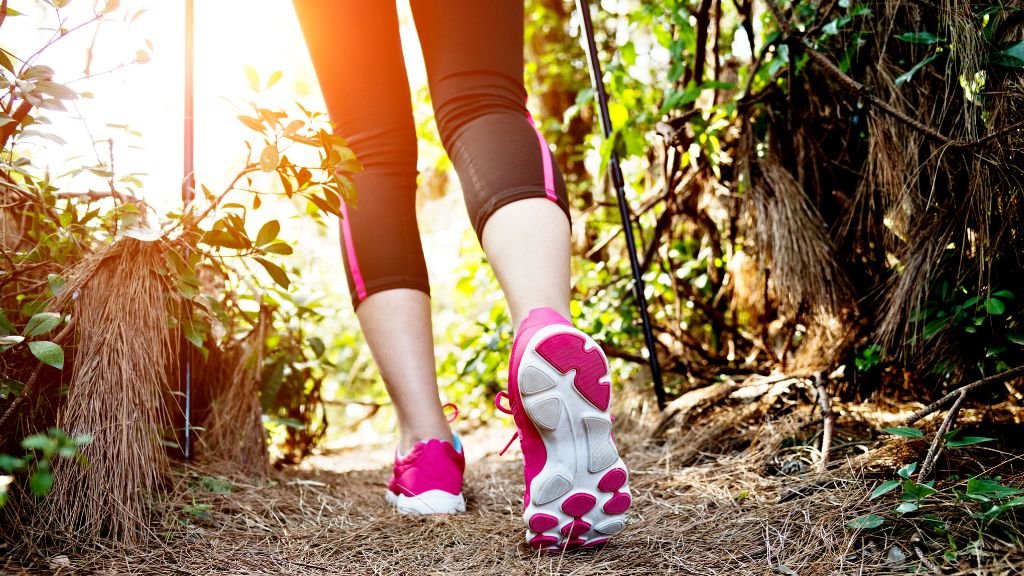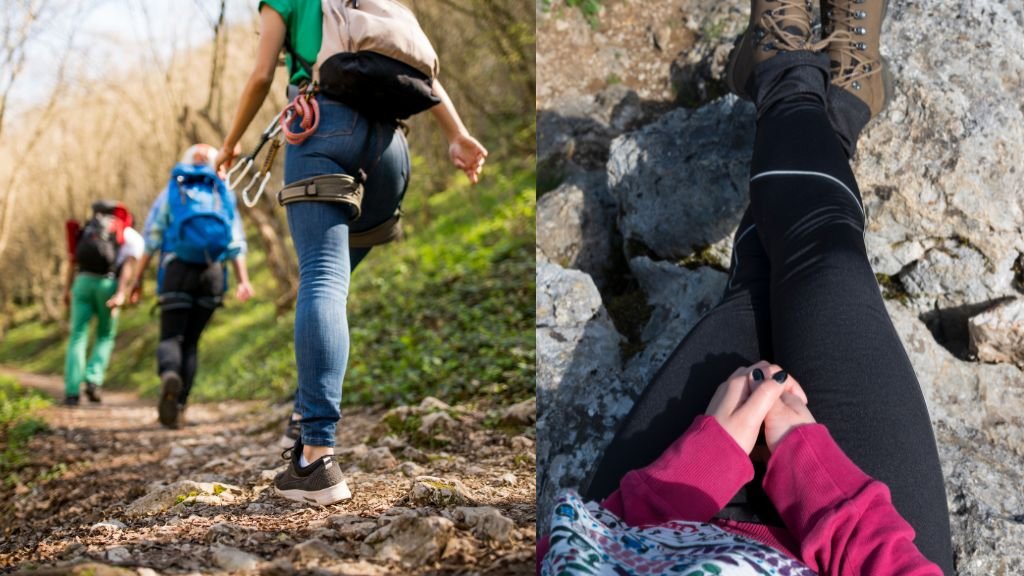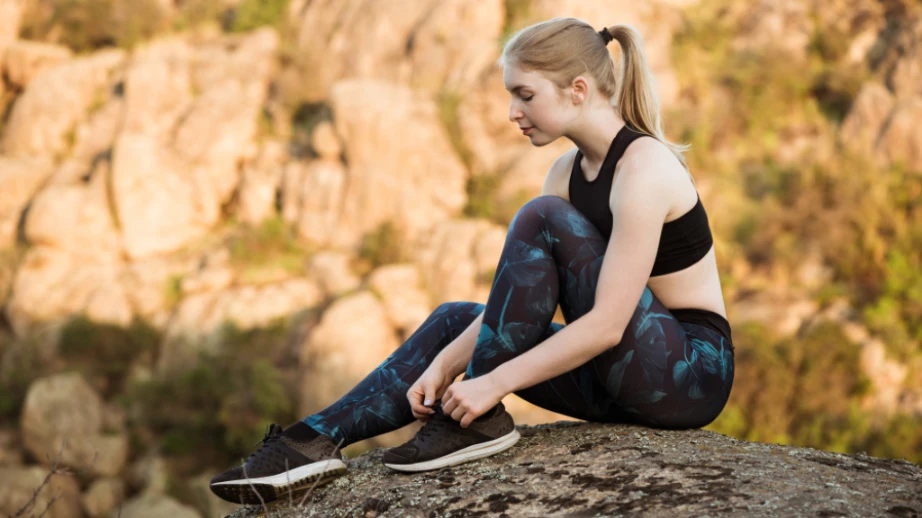Are you eyeing those stretchy leggings for your next gike? Sure, they’re comfy, but are they the right choice for hitting the trails?
This article dives into what matters when you pick out gear for a hike. From scratchy bushes to unexpected weather, we’ll weigh up the good and bad of choosing leggings.
Read on to find out how to make the best decision for comfort and safety on your journey. There’s more to consider than just fashion when nature calls!
Is It OK to Hike in Leggings?
Yes, it’s OK to hike in leggings. Leggings are a popular choice for hikers looking for comfort and breathability on the trails. They’re suitable for less demanding day hikes thanks to their flexibility and light weight.
Many hikers favor moisture-wicking athletic tights over cotton since they keep you dry and comfortable. It’s important, however, to avoid cotton leggings as they don’t offer the same benefits and may lead to discomfort.
For more technical hikes or longer journeys, you might want to consider dedicated hiking pants. These pants are designed to withstand rugged conditions, offering additional protection against the elements and rough terrain.
Pros of Hiking in Leggings
Hiking in leggings has become quite popular. If you’re wondering why here’s an in-depth guide that’ll help you see the advantages of choosing leggings for your next outdoor hike.
Versatility
One of the best things about leggings is how they work for many different situations. You can wear them all year long. In cold weather, leggings keep you warm under a pair of waterproof pants. During hot summer days, they are light and keep you cool. Here are ways leggings prove their versatility:
- Layer Up: When it’s chilly, start with a base layer of thin leggings, then add more layers as needed.
- Stand Alone: On warmer days, just one pair of breathable leggings will do the trick.
- Variety of Materials: You’ll find options for every season, from thermal to lightweight leggings.
Quick Drying
Leggings made from materials like nylon or polyester have a special talent: they dry super fast! This is great for several reasons:
- Water Crossings: If you walk through streams or get caught in a puddle, your leggings will dry much quicker than regular pants.
- Rainy Days: Get surprised by a rain shower? No worries, your leggings won’t stay wet for long.
Fashionable and Functional
Who says you can’t look great while exploring nature? Leggings come in so many styles – there’s something for everyone. They are not just for looking good; they serve a purpose too:
- Wide Range: From solid colors to wild prints, choose a style that shows off your personality.
- Storage Options: Some leggings come with pockets to hold small items like a phone or keys.
While you enjoy the views from the trail, leggings help you express yourself without saying a word.
Cons of Hiking in Leggings
While leggings might be comfortable for hikes, they do have some drawbacks. Let’s explore the reasons why they might not always be the best choice.
Durability Concerns
When you’re out in the wild, walking through thick bushes or brushing up against rocks, your clothes need to be tough. Leggings, however, can let you down:
- Snags and Tears: Leggings can easily catch on sharp objects and tear.
- Wear and Tear: Over time, the fabric might thin out, especially if you’re hiking rough trails often.
It’s worth thinking about the terrain you’ll be exploring. If it’s a place with lots of rocks and branches, you might want heavier gear.
Limited Protection
Even though leggings are light and cool, they don’t offer much shield against the outdoors:
- Sunburns: Thin leggings often don’t protect you from the sun’s harmful rays.
- Scratches: Walking through tall grass or shrubs? Leggings won’t guard your skin like thick pants would.
- Bugs: In places with lots of insects, like swamps or dense woods, leggings won’t keep bites at bay.
Think about what kind of protection you’ll need based on where you’re hiking. Sometimes, more coverage is better.
Lack of Pockets/Storage
Another thing to consider is where you’ll stash your stuff. Here’s why leggings might make that hard:
- Fewer Pockets: Most leggings don’t have pockets. If they do, they’re usually small.
- Carrying Essentials: With no place to put things, you may need to carry an extra bag or pack.
Best Practices for Hiking in Leggings
To make sure your hike is both enjoyable and safe, let’s go through some best practices for hiking in leggings.
Choosing the Right Material
To start, picking good-quality leggings is key:
- Durable Fabrics: Choose leggings made to last. Look for materials that can handle rough trails.
- Moisture-Wicking: Sweat can be a problem on long hikes. Find leggings that keep you dry.
Fabrics like nylon or spandex are often good choices. They are strong and dry quickly. If you hike places with many brambles or jagged rocks, consider thicker leggings.
Layering for Weather Conditions
You can hike in leggings any time of the year if you layer right:
- Cold Weather: Wear thermal leggings as a base layer. You can also put waterproof pants over them if it’s really cold or wet.
- Warm Weather: Lighter, breathable leggings work best. They help keep you cool.
It’s smart to check the weather before your hike. Knowing if it will be hot, cold, or rainy helps you dress right.
Safety Considerations
Staying safe while hiking in leggings means thinking ahead:
- Sun Protection: If you hike in sunny places, wear a long top to cover more skin. Sunscreen is also important.
- Dense Vegetation: You might want an extra layer of protection. A lightweight pair of pants over your leggings can help.
In areas like deserts or high-altitude trails, the sun can be strong. Places with thick woods or thorny bushes need more care. Always plan for where you are going.
Alternatives to Leggings for Hiking
Sometimes, you need something tougher than leggings when you hit the trails. Let’s explore some great choices you have for hiking wear.
Hybrid Hiking Tights
Think of hybrid hiking tights as the stronger cousin of everyday leggings. They are made for people who hike and want to stay comfortable:
- Tougher Material: These tights won’t tear easily on rocks or branches.
- Extra Features: Some have pockets and areas that are made stronger for more protection.
Hybrid tights blend the snug fit of leggings with rugged features. With them, you won’t worry so much about tears. You can keep small items in the pockets too.
Traditional Hiking Pants
When you hear “hiking pants,” you might think of something not so stylish. But they have a lot going for them:
- Built to Last: These pants can take a lot of wear and tear.
- Protection: They shield you from sun, sharp plants, and bugs.
When you pick between leggings and traditional pants, think about where you are hiking. Dry deserts, high mountains, or tight forests each have different needs. Pants often have lots of pockets too, which is handy.
Conclusion
Before you head out, think about the conditions you’ll face. Will there be rough terrain, harsh weather, or lots of bugs? Do you need more pockets for your gear? These are the questions to answer when deciding if leggings are the best choice for your hike.

Martha Heller
Hey there! I’m Martha, the face behind BigfootHiking.com – a blog I created alongside my husband Lukas. Originally from Phoenix, I’ve made hiking my life’s passion. With over 100 hikes under my belt in the past 7 years, and still counting, I’m always on the move. One of my proudest achievements was conquering Angel’s Landing in Zion National Park. When I’m not on the trails, you’ll find me tinkling on the piano or lost in my drawings. Drop by our blog for tips, tales, and plenty of trail inspiration!



